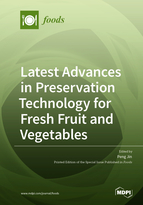Latest Advances in Preservation Technology for Fresh Fruit and Vegetables
A special issue of Foods (ISSN 2304-8158). This special issue belongs to the section "Food Engineering and Technology".
Deadline for manuscript submissions: closed (1 August 2022) | Viewed by 30307
Special Issue Editor
Special Issue Information
Dear Colleagues,
Fresh fruit and vegetables are considered an essential component of a healthy human diet for their good taste and rich nutrients. However, fruits and vegetables are characterized by production seasonality, regionality, and perishability, which greatly affect the acceptance of consumers and increase the challenges of their postharvest storage and preservation. A plurality of preservation technologies, including chemical treatment (calcium chloride, 1-Methylcyclopropene, salicylic acid, etc.), physical methods (low temperature conditioning, controlled atmosphere storage, ultraviolet-C irradiation, etc.), and biotechnology (such as genetic engineering technology) have been applied to maintain storage quality and to extend the storage life of fresh fruit and vegetables in recent years. Developing advanced preservation techniques to prolong the storage life of fruit and vegetables is of importance for improving social and economic benefits.
Therefore, we would like to invite authors to contribute original research articles as well as review articles focused on the innovative preservation technology of fresh produce, addressing storage problems, such as postharvest quality deterioration caused by senescence, physiological disorder, and disease, to extend shelf-life and reduce postharvest loss.
Prof. Dr. Peng Jin
Guest Editor
Manuscript Submission Information
Manuscripts should be submitted online at www.mdpi.com by registering and logging in to this website. Once you are registered, click here to go to the submission form. Manuscripts can be submitted until the deadline. All submissions that pass pre-check are peer-reviewed. Accepted papers will be published continuously in the journal (as soon as accepted) and will be listed together on the special issue website. Research articles, review articles as well as short communications are invited. For planned papers, a title and short abstract (about 100 words) can be sent to the Editorial Office for announcement on this website.
Submitted manuscripts should not have been published previously, nor be under consideration for publication elsewhere (except conference proceedings papers). All manuscripts are thoroughly refereed through a single-blind peer-review process. A guide for authors and other relevant information for submission of manuscripts is available on the Instructions for Authors page. Foods is an international peer-reviewed open access semimonthly journal published by MDPI.
Please visit the Instructions for Authors page before submitting a manuscript. The Article Processing Charge (APC) for publication in this open access journal is 2900 CHF (Swiss Francs). Submitted papers should be well formatted and use good English. Authors may use MDPI's English editing service prior to publication or during author revisions.
Keywords
- fruit and vegetables
- quality deterioration
- physiological disorder
- disease
- chemical preservation technology
- physical preservation technology
- biotechnology







